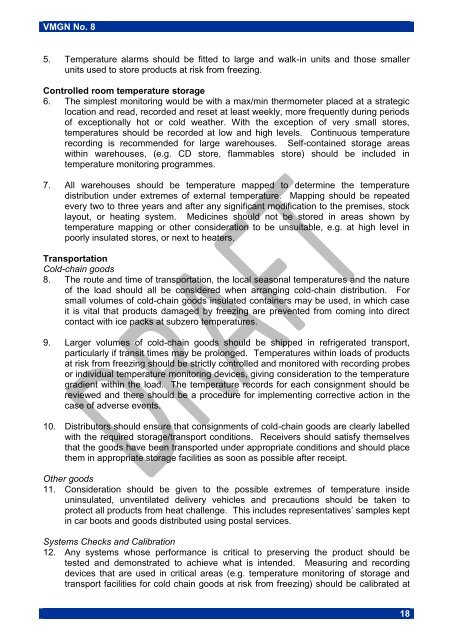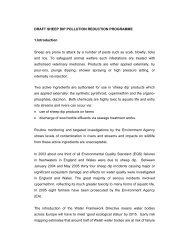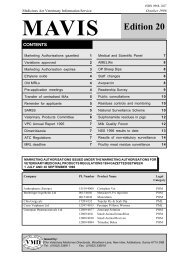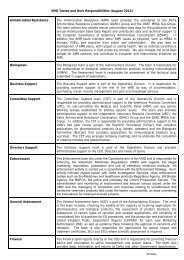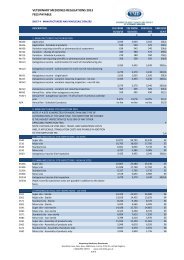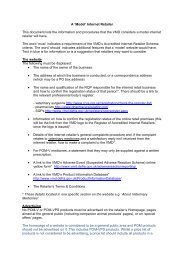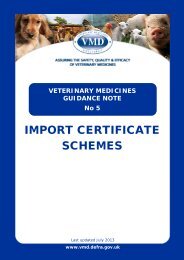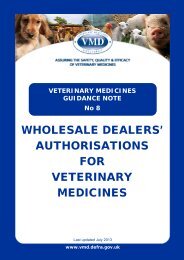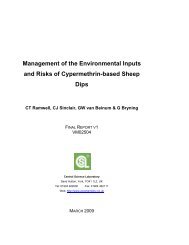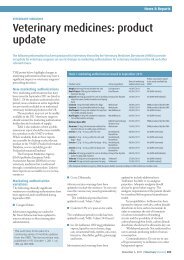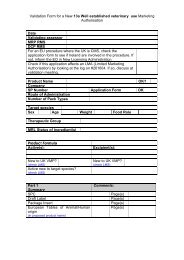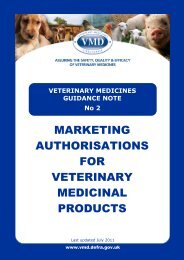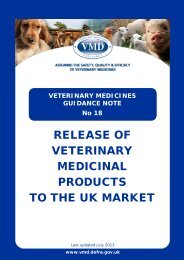TABLE OF CONTENTS - Veterinary Medicines Directorate - Defra
TABLE OF CONTENTS - Veterinary Medicines Directorate - Defra
TABLE OF CONTENTS - Veterinary Medicines Directorate - Defra
- No tags were found...
Create successful ePaper yourself
Turn your PDF publications into a flip-book with our unique Google optimized e-Paper software.
VMGN No. 85. Temperature alarms should be fitted to large and walk-in units and those smallerunits used to store products at risk from freezing.Controlled room temperature storage6. The simplest monitoring would be with a max/min thermometer placed at a strategiclocation and read, recorded and reset at least weekly, more frequently during periodsof exceptionally hot or cold weather. With the exception of very small stores,temperatures should be recorded at low and high levels. Continuous temperaturerecording is recommended for large warehouses. Self-contained storage areaswithin warehouses, (e.g. CD store, flammables store) should be included intemperature monitoring programmes.7. All warehouses should be temperature mapped to determine the temperaturedistribution under extremes of external temperature. Mapping should be repeatedevery two to three years and after any significant modification to the premises, stocklayout, or heating system. <strong>Medicines</strong> should not be stored in areas shown bytemperature mapping or other consideration to be unsuitable, e.g. at high level inpoorly insulated stores, or next to heaters.TransportationCold-chain goods8. The route and time of transportation, the local seasonal temperatures and the natureof the load should all be considered when arranging cold-chain distribution. Forsmall volumes of cold-chain goods insulated containers may be used, in which caseit is vital that products damaged by freezing are prevented from coming into directcontact with ice packs at subzero temperatures.9. Larger volumes of cold-chain goods should be shipped in refrigerated transport,particularly if transit times may be prolonged. Temperatures within loads of productsat risk from freezing should be strictly controlled and monitored with recording probesor individual temperature monitoring devices, giving consideration to the temperaturegradient within the load. The temperature records for each consignment should bereviewed and there should be a procedure for implementing corrective action in thecase of adverse events.10. Distributors should ensure that consignments of cold-chain goods are clearly labelledwith the required storage/transport conditions. Receivers should satisfy themselvesthat the goods have been transported under appropriate conditions and should placethem in appropriate storage facilities as soon as possible after receipt.Other goods11. Consideration should be given to the possible extremes of temperature insideuninsulated, unventilated delivery vehicles and precautions should be taken toprotect all products from heat challenge. This includes representatives‟ samples keptin car boots and goods distributed using postal services.Systems Checks and Calibration12. Any systems whose performance is critical to preserving the product should betested and demonstrated to achieve what is intended. Measuring and recordingdevices that are used in critical areas (e.g. temperature monitoring of storage andtransport facilities for cold chain goods at risk from freezing) should be calibrated at18


